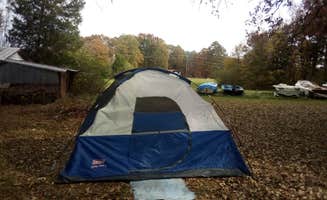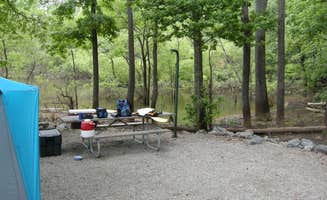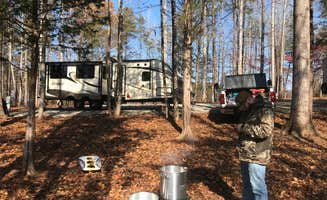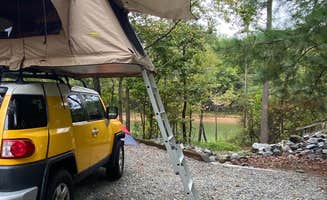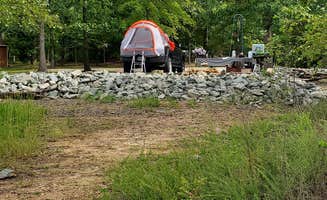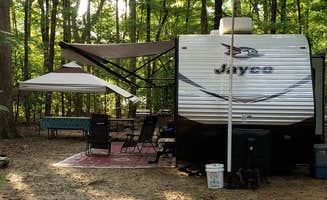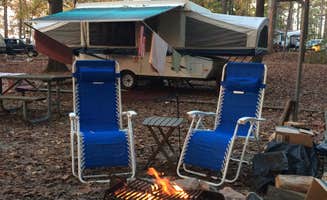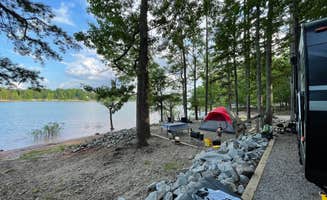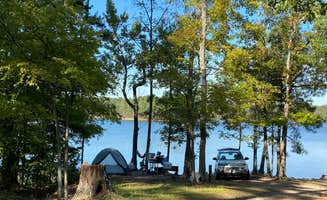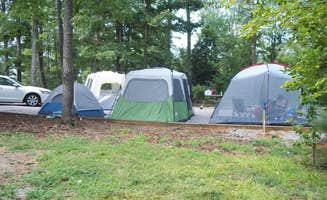Camping options near Red Oak, Virginia primarily cluster around Kerr Reservoir, also known locally as Buggs Island Lake. The area sits within the Virginia Piedmont region at approximately 300 feet elevation, characterized by gently rolling hills and extensive waterfront. Most campgrounds in the area operate seasonally with peak camping from April through October when daytime temperatures typically range from 70-90°F. Nights can remain warm in summer with high humidity levels typical of the mid-Atlantic region.
What to do
Kayaking and paddling access: Occoneechee State Park Campground offers excellent water access with multiple launch points. "Awesome spot - spacious camping spots along the most beautiful cliffs - hiking was wonderful with wildlife galore! Kayaking was the BEST experience I have had yet!" notes Julie A. The park maintains designated swimming areas and boat rentals during peak season.
Stargazing opportunities: The night sky viewing at Kerr Lake can be exceptional due to minimal light pollution. "The sky and stars were amazing! If you love stargazing this is the park for you. It is an International Dark Sky Park," reports Bridget H. from Staunton River State Park Campground. Visitors can borrow telescopes from the visitor center at no charge.
Fishing expeditions: The reservoir contains multiple fish species including bass and catfish. "Fishing around the campsite was great; not hard to catch fish there!" reports Kelli H. from Rudds Creek. Multiple fishing piers and boat launches allow both shoreline fishing and deeper water access, with best results reported during early morning or evening hours.
Trail exploration: Multiple trail systems run through the parks surrounding Red Oak. "Mayo Lake Park provides extensive trails, lots of clearly marked hiking trails, 3 playgrounds, Frisbee golf and horseshoe pits," notes adam B. The trails range from short, accessible paths to more challenging routes with moderate elevation changes.
What campers like
Lake access from campsites: Many sites offer direct water frontage with private beach areas. "Sites are right on the water! The lot was level and I didn't feel like I was on top of my neighbors," writes Heather about North Bend Park. These waterfront sites often feature gradual sandy entries into the water, making them ideal for swimming and boat launching.
Spacious, well-designed sites: Campground layouts typically provide adequate separation between campsites. "The sites are well kept and the layout of the sites were well thought out. The Army Corp. does a great job with their campgrounds," notes Glenn F. about Rudds Creek Campground. Most sites include fire rings, picnic tables, and level pads for camping equipment.
Clean, well-maintained facilities: Despite being rural locations, most developed campgrounds maintain good facility standards. "Bathrooms are within walking distance from all campsites. Nice clean, hot showers!" reports Katie M. Shower facilities are typically available at centralized bath houses while vault toilets may be positioned throughout camping loops for easier access.
Wildlife viewing opportunities: The area supports diverse wildlife populations. "While staying there I saw a skunk, a groundhog, several deer and a great variety of birds. We enjoyed gorgeous sunsets from a little beach area near the cabins," shares Elena B. Morning and evening hours offer the best wildlife viewing opportunities along shorelines and forest edges.
What you should know
Gravel tent pads: Many sites have gravel surfaces that may be uncomfortable for tent camping without proper equipment. "Who tents on gravel when you have to sleep on the ground? Not cool," notes Kelly J. about Buffalo Park. Tent campers should bring thick pads or cots for comfort on these surfaces.
Water access varies by site: Water spigot locations can be inconsistent throughout campgrounds. "Note: Site 77 required 75 feet of hose to reach water nozzle. Website said 35' so glad we were prepared," writes S K. about Hibernia Campground. RVers should pack extra-long water hoses to ensure proper hookup.
Limited cellular service: Mobile connectivity can be unreliable throughout the region. "No WiFi. Verizon device at the campground worked okay," reports Harry B. about Occoneechee State Park. T-Mobile coverage appears to be more consistent than AT&T in several campgrounds.
Seasonal operating schedules: Most campgrounds operate on limited schedules. "The campground is just nice all around. The current camp hosts are over the top. Super nice people who make you feel welcomed from the minute you arrive," notes Glenn F. Many sites close completely between November and March with reduced services during shoulder seasons.
Tips for camping with families
Swimming areas: Hibernia Campground provides family-friendly water access with gradual entry points. "We had a great site, right on the lake. Could launch our kayaks, fish and swim right from our site! Was a great way to cool off and just enjoy the beautiful water," shares Jeanna Marie C. The coves offer calmer water conditions compared to main lake areas.
Playground availability: Several campgrounds maintain playground equipment for children. "The park has a nice day use area across the road with a nice swimming area. There is also a swimming beach within the campground," shares Glenn F. about Rudds Creek. Most playgrounds are basic but provide swings and climbing structures.
Educational programming: Ranger-led programs operate during summer months at select parks. "Park rangers had great kids programs including animal feeding frenzy where we learned about snakes and turtles and we invoked in feeding. Also lots of any pelts to learn about," notes Katie from Staunton River State Park.
Site selection for privacy: Family groups should carefully consider campsite location relative to facilities. "Bathhouses are within walking distance from all campsites. Ours was a bit of a walk uphill but not bad," explains Wendy H. Sites near bath houses experience more foot traffic while distant sites require longer walks for children.
Tips from RVers
Site leveling challenges: Many sites require careful positioning for proper leveling. "The sites have ample room and they're spaced far enough apart that you actually have privacy (unless you camp on the waterfront where they're smaller and close together)," writes Lisa M. about Occoneechee State Park. Bring leveling blocks as many sites have slight to moderate slopes.
Hookup limitations: Full hookups are uncommon in the region. "Mostly small small sites but some larger sites. All sites have water and electricity. There is a single dump station near the entrance," explains Brandon C. about Mayo Lake Park. Most campgrounds provide water and electric but limited sewer connections.
Road considerations: Internal campground roads may present navigation challenges. "The road leading to the camping area is single lane so if you meet another camper going the other way it could get a little dicey," cautions Brandon C. Larger rigs should arrive during daylight hours for easier maneuvering.
Shade availability: Tree coverage varies significantly between sites and campgrounds. "We stayed in a non-electric site and in November is was in the 30's at night - pretty cold for tent camping! But we bundled up and made lots of fires!" notes Katie M. RVers requiring solar access should request more open sites while those needing shade should check specific site descriptions.


